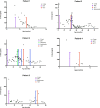Enzyme replacement therapy and hematopoietic stem cell transplant: a new paradigm of treatment in Wolman disease
- PMID: 34020687
- PMCID: PMC8139039
- DOI: 10.1186/s13023-021-01849-7
Enzyme replacement therapy and hematopoietic stem cell transplant: a new paradigm of treatment in Wolman disease
Abstract
Background: Wolman disease is a rare, lysosomal storage disorder in which biallelic variants in the LIPA gene result in reduced or complete lack of lysosomal acid lipase. The accumulation of the substrates; cholesterol esters and triglycerides, significantly impacts cellular function. Untreated patients die within the first 12 months of life. Clinically, patients present severely malnourished, with diarrhoea and hepatosplenomegaly, many have an inflammatory phenotype, including with hemophagocytic lymphohistiocytosis (HLH). Hematopoietic stem cell transplant (HCT) had been historically the only treatment available but has a high procedure-related mortality because of disease progression and disease-associated morbidities. More recently, enzyme replacement therapy (ERT) with dietary substrate reduction (DSR) has significantly improved patient survival. However, ERT is life long, expensive and its utility is limited by anti-drug antibodies (ADA) and the need for central venous access.
Results: We describe five Wolman disease patients diagnosed in infancy that were treated at Royal Manchester Children's Hospital receiving ERT with DSR then HCT-multimodal therapy. In 3/5 an initial response to ERT was attenuated by ADA with associated clinical and laboratory features of deterioration. 1/5 developed anaphylaxis to ERT and the other patient died post HCT with ongoing HLH. All patients received allogeneic HCT. 4/5 patients are alive, and both disease phenotype and laboratory parameters are improved compared to when they were on ERT alone. The gastrointestinal symptoms are particularly improved after HCT, with reduced diarrhoea and vomiting. This allows gradual structured normalisation of diet with improved tolerance of dietary fat. Histologically there are reduced cholesterol clefts, fewer foamy macrophages and an improved villous structure. Disease biomarkers also show improvement with ERT, immunotherapy and HCT. Three patients have mixed chimerism after HCT, indicating a likely engraftment-defect in this condition.
Conclusion: We describe combined ERT, DSR and HCT, multimodal treatment for Wolman disease. ERT and DSR stabilises the sick infant and reduces the formerly described prohibitively high, transplant-associated mortality in this condition. HCT abrogates the problems of ERT, namely attenuating ADA, the need for continuing venous access, and continuing high cost drug treatment. HCT also brings improved efficacy, particularly evident in improved gastrointestinal function and histology. Multimodal therapy should be considered a new paradigm of treatment for Wolman disease patients where there is an attenuated response to ERT, and for all patients where there is a well-matched transplant donor, in order to improve long term gut function, tolerance of a normal diet and quality of life.
Keywords: Dietary substrate reduction (DSR); Enzyme replacement therapy (ERT); Gene therapy; Hematopoietic stem cell transplant (HCT); Hemophagocytic lymphohistiocytosis (HLH); Lysosomal acid lipase (LAL); Lysosomal storage disorders (LSD); Wolman disease.
Conflict of interest statement
Authors had no competing interests unless listed below. SJhas received consultancy fees, grants, and travel support for conferences from Alexion Pharmaceuticals, Inc. AGhas received consultancy fees/honoraria from Alexion Pharmaceuticals, Inc. FWhas received consultancy fees/honoraria from Alexion Pharmaceuticals, Inc.
Figures







References
-
- https://www.omim.org/entry/278000. 2020. Cited 01 Feb 2020.
-
- Anderson RA, Rao N, Byrum RS, Rothschild CB, Bowden DW, Hayworth R, et al. In situ localization of the genetic locus encoding the lysosomal acid lipase/cholesteryl esterase (LIPA) deficient in Wolman disease to chromosome 10q23.2q23.3. Genomics. 1993;15(1):245–247. doi: 10.1006/geno.1993.1052. - DOI - PubMed
-
- Wolman M, Sterk VV, Gatt S, Frenkel M. Primary familial xanthomatosis with involvement and calcification of the adrenals. Report of two more cases in siblings of a previously described infant. Pediatrics. 1961;28:742–757. - PubMed
Publication types
MeSH terms
Substances
Grants and funding
LinkOut - more resources
Full Text Sources
Other Literature Sources
Research Materials

